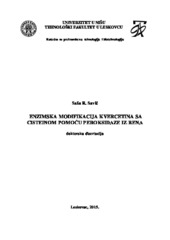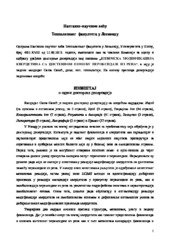Приказ основних података о дисертацији
Enzimska modifikacija kvarcetina sa cisteinom pomoću peroksidaze iz rena
| dc.contributor.advisor | Petronijević, Živomir | |
| dc.contributor.other | Šmelcerović, Andrija | |
| dc.contributor.other | Nikolić, Nada | |
| dc.creator | Savić, Saša R | |
| dc.date.accessioned | 2016-06-25T19:06:38Z | |
| dc.date.available | 2016-06-25T19:06:38Z | |
| dc.date.available | 2020-07-03T16:13:44Z | |
| dc.date.issued | 2015-12-17 | |
| dc.identifier.uri | https://nardus.mpn.gov.rs/handle/123456789/5544 | |
| dc.identifier.uri | http://eteze.ni.ac.rs/application/showtheses?thesesId=2967 | |
| dc.identifier.uri | https://fedorani.ni.ac.rs/fedora/get/o:1070/bdef:Content/download | |
| dc.identifier.uri | http://vbs.rs/scripts/cobiss?command=DISPLAY&base=70052&RID=47449103 | |
| dc.description.abstract | n this thesis the modification of quercetin with L-cysteine by horseradish peroxidase (HRP) was investigated. At the beginning of the experimental work, the process of quercetin oxidation by HRP was investigated, and after that the process of quercetin oxidation by HRP in the presence of L-cysteine as a nucleophile agent was studied. Obtained products of quercetin oxidation by HRP were identified by using the new UHPLC-HESI-DAD-MS/MS method. In addition, the kinetic mechanism of the enzymatic reaction of quercetin modification was also examined. In the final part of the experimental work, immobilization of HRP through hydrophobic interaction was done, and reaction of quercetin modification with immobilized HRP was optimized. Results of quercetin oxidation with HRP revealed the presence of more than ten different compounds, and among the identified compounds there were: quercetin quinones and its derivatives, phloroglucinol carboxylic acid, protocatechuic acid, quercetin hetorodimer and its derivatives. On the other hand, results from quercetin oxidation by HRP in the presence of L-cysteine demonstrated that the reaction leads to the formation of two new compounds which are identified as cysteinylquercetin adducts. Also, it was found that L-cysteine has the ability to capture previously formed products of quercetin oxidation (ROS), which can be of great importance if we take into account the adverse effects that occur as a result of ROS effects. Results from investigations of the kinetic mechanism of reaction of quercetin modification with L-cysteine by HRP showed that the modification process was performed as ordered kinetic mechanism. Optimization of the reaction of quercetin modification with L-cysteine by HRP showed that at the temperature of 35 °C and pH 6.8 the greatest amount of cysteinylquercetin adducts were obtained. In addition, the results from investigations of infuence of quercetin and L-cysteine concentrations on the reaction of modification revealed that it is necessary that both substrates are present in a ratio of 1:1. On the other hand, the results from testing the effects of hydrogen peroxide concentration on the reaction of quercetin modification showed that the highest amount of modified products at 0.26 mM was obtained, whereby at higher concentrations of hydrogen peroxide inhibitory effect on HRP was observed. VIII Investigations of the presence of organic solutions in reaction mixture of 5 ml showed that in the presence of 5% DMSO, the amount of cysteinylquercetin adducts were 9.5-fold higher. Expected generated amount of cysteinylquercetin adducts in reaction mixture of 100 ml was about 27 mg. Results from optimization of reaction of quercetin modification by immobilized HRP demonstrated a slightly lower amount of cysteinylquercetin adducts at optimal values when compared to their amount obtained in the reaction with free HRP, which is probably a result of initial lower activity of immobilized HRP. On the other hand, in the presence of immobilized HRP at more drastic reaction conditions, amount of cysteinylquercetin adducts was higher then in the presence of free HRP, which could be explained by higher stability of immobilized HRP. Although the amount of generated cysteinylquercetin adducts were slightly higher in the case when free HRP was used in the reaction of quercetin modification, immobilized HRP could still be advantageous, primarily due to the number of advantages that it brings. The optimum values of temperature, pH and quercetin, L-cysteine and hydrogen peroxide concentrations to obtain cysteinylquercetin adducts when in reaction mixture immobilized HRP were: 37 °C, 7.0, 0.14 mM, 0.15 mM and 0.26 mM, respectively. | en |
| dc.format | application/pdf | |
| dc.language | sr | |
| dc.publisher | Универзитет у Нишу, Технолошки факултет, Лесковац | sr |
| dc.relation | info:eu-repo/grantAgreement/MESTD/Technological Development (TD or TR)/34012/RS// | |
| dc.rights | openAccess | en |
| dc.rights.uri | https://creativecommons.org/licenses/by-nc-nd/4.0/ | |
| dc.source | Универзитет у Нишу | sr |
| dc.subject | Peroksidaza iz rena | sr |
| dc.subject | Horseradish peroxidase | en |
| dc.subject | Quercetin | en |
| dc.subject | L-cysteine | en |
| dc.subject | Oxidation | en |
| dc.subject | Modification | en |
| dc.subject | Kvercetin | sr |
| dc.subject | L-cistein | sr |
| dc.subject | Oksidacija | sr |
| dc.subject | Modifikacija | sr |
| dc.title | Enzimska modifikacija kvarcetina sa cisteinom pomoću peroksidaze iz rena | sr |
| dc.type | doctoralThesis | en |
| dc.rights.license | BY-NC-ND | |
| dcterms.abstract | Петронијевић, Живомир; Шмелцеровић, Aндрија; Николић, Нада; Савић, Саша Р; Ензимска модификација кварцетина са цистеином помоћу пероксидазе из рена; Ензимска модификација кварцетина са цистеином помоћу пероксидазе из рена; | |
| dc.identifier.fulltext | https://nardus.mpn.gov.rs/bitstream/id/54603/Disertacija3469.pdf | |
| dc.identifier.fulltext | https://nardus.mpn.gov.rs/bitstream/id/54604/Savic_Sasa_R.pdf | |
| dc.identifier.fulltext | http://nardus.mpn.gov.rs/bitstream/id/54603/Disertacija3469.pdf | |
| dc.identifier.fulltext | http://nardus.mpn.gov.rs/bitstream/id/54604/Savic_Sasa_R.pdf | |
| dc.identifier.rcub | https://hdl.handle.net/21.15107/rcub_nardus_5544 |



